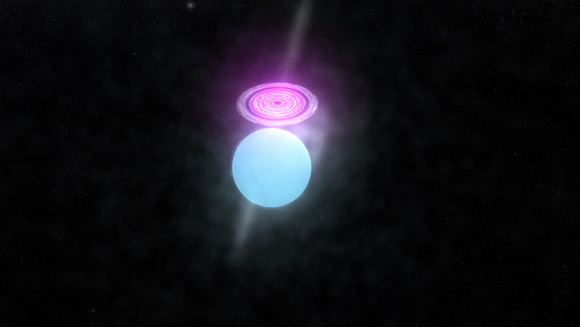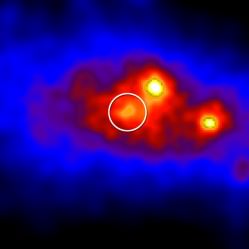Fermi’s Large Area Telescope has detected bursts of gamma-rays in the binary system Cygnus X-3, which astronomers say are coming from a microquasar. While microquasars have strong emissions across is a broad range of wavelengths, this is the first time this type of object has been detected in gamma rays. “Cygnus X-3 is a genuine microquasar and it’s the first for which we can prove high-energy gamma-ray emission,” said Stéphane Corbel at Paris Diderot University in France.

Microquasars are stellar mass object that displays in miniature some of the properties of quasars: a normal star begins shedding its matter onto either a neutron star or a black hole. This phenomenon produces large amounts of radiation and “jets” of material moving at relativistic speeds—more than 10% the speed of light—away from the star. These “relativistic jets” are a great mystery that astronomers are still trying to understand, but this new gamma-ray microquasar could provide new ways to study them.
At the center of Cygnus X-3 lies a massive Wolf-Rayet star. With a surface temperature of 100,255.372 Kelvin (180,000 degrees F,) or about 17 times hotter than the sun, the star is so hot that its mass bleeds into space in the form of a powerful outflow called a stellar wind. “In just 100,000 years, this fast, dense wind removes as much mass from the Wolf-Rayet star as our sun contains,” said Robin Corbet at the University of Maryland, Baltimore County.
The researchers matched the gamma-rays to the known orbital period of the Cygnus X-3 microquasar in order to confirm that the strong pulses of radiation were, in fact, originating from the object. They also matched the gamma-rays with radio emission from the relativistic jets of Cygnus X-3.

Every 4.8 hours, a compact companion embedded in a disk of hot gas wheels around the star. “This object is most likely a black hole, but we can’t yet rule out a neutron star,” Corbet said.
Between Oct. 11 and Dec. 20, 2008, and again between June 8 and Aug. 2, 2009, Cygnus X-3 was unusually active. The team found that outbursts in the system’s gamma-ray emission preceded flaring in the radio jet by roughly five days, strongly suggesting a relationship between the two.
These new findings should provide more information about the formation of such mysterious and fast-moving relativistic jets. This research appears in the 26 November issue of Science Express.
Read the team’s abstract
Sources: Science, Goddard Spaceflight Center


For us Imperially challenged that’s 100 kK according to Fr Google.
I lurrve Fermi.
Eh? 180,000 degrees F.
What’s that in Celsius or even Kelvin? (or are we returning to the bad ol’ days???)
Is there anything known about a paper to come? I would like to know if there is a spectrum available!
And what the heck is Fahrenheit? Curse you, Americans, no one in the whole world uses this stupid system, but you must always stand aside!
Sorry, this wanted to be said 😉 😀
Great article, Nancy!
Sorry about forgetting to convert…..
The paper is now available online.
If the temperature is 180,000F that is pretty easy to convert to K 🙂 God that is a hot star. I suppose all that material flying off is what feeds the compact companion.
Happy T-day LC
I thought I would give a pitch for the old English system of units. They are terribly useless for science, and cumbersome for engineering. Thought US industry still uses it. There is something to be said for it all. In cooking a dinner, such as right now while taking some email and blog time in between going to the kitchen, I would find it horrible to use grams, milliliters, and so forth. The one thing the English system (which is a vestige of medieval systems) offers is things go in doubles and halves, teaspoons, tablespoons, cups, pints, quarts, etc. And after all a liter is a little bigger than a quart, so it is not that hard to convert. When it comes to weights ounces and pounds are easier to work with for lots of ordinary things than grams and kilograms. An ounce is about the perfect unit of weight for — well cooking again. With temperature, Fahrenheit is more useful for ordinary things, as the units are smaller. I can think Celsius or Kelviin in science, but not the daily weather. For length measurements the English system is not as convenient over metric. I do wish my country would go more metric, but still keep the English system. It will teach students on how units are scalable and not absolute.
Cheers LC
@ LBC
I guess, especially in every-day-life this is a matter of familiarization. I perfectly know what it means when we have 10°C out there. This is also true for any forms of measurements. I am used to it, so as you are to the old English system.
But what ever…. have a nice, tasty meal! 🙂
I’ll take the pitch for Imperial units with a grain of salt.
[Actually, I think it’s kind of sad.
It has taken humans such a long time to go from “egocentric” local units to objectively standardized. Every time I see non-SI units, outside of convenient specialty measures, I’m reminded of that long and arduous journey.]
The old units were made by humans to represent human scales of understanding. They were not designed with much hard core science in mind.
That said, you tell someone how hot something is in Kelvin and they often give you a blank stare. Tell them its some fantastically large number of Fahrenheit’s and they say “Sweet Jesus, thats HOT!”.
Its often a choice between being understood or being snooty.
Screw it all. I exclusively use natural units. Velocity, angular momentum and energy are my base quantities.The speed of light = 1. hbar = 1. Energy is measured in eV. Mass, length and time are derived.
I henceforth request that all measurements on this site be expressed in terms of my chosen base quantities.
It’s easier for cooking that way too: i.e., add 3.12261397*10^7 E .V^?2 of flour to the mix. Open the oven and cook for for 3*10^3 L.E^?1. Etc. More intuitive I think.
“100,255.372 Kelvin”
Thanks for converting, but I doubt very much anything beyond the 2nd digit is at all realistic. 100,000 K would have been good enough.
Edit latest post: please read _significant_ instead of _realistic_.
Manu, actually it works both ways.
Fascinating. What is the measure of “snooty”? If it can’t be measured it doesn’t exist, you know. 😀
[Unless it’s a part of a larger theory. Presumably, in the context we are discussing a theory on social communication. Or is it a theory on social perception? 😉
FWIW, the process of being understood can presumably be measured as Shannon information. _What_ is understood is another problem. (o.O)]
@ Astrofiend:
Of course one could use natural units, anything else would be unnatural, wouldn’t it? :-/ Remind me to not ask you about recipes.
But, you touch on the problem of which natural units to use. Free space units, atomic units, … A standardized measurement system has to be decided by convention. Yes, it’s choice, but it’s not your choice.
Manu said;
“100,255.372 Kelvin”
Thanks for converting, but I doubt very much anything beyond the 2nd digit is at all realistic. 100,000 K would have been good enough.
Sorry, You fail to see the point. There are young people in the world who don’t even know about the Fahrenheit scale but only Celsius.
While it might seem like pertinacity, it is important to communicate in the language of science and units being used.. There is enough problems in learning astronomical terms than confuse it with inconsistency.
Really, it would have been better to say “the temperatures is 100,000 degrees” – avoiding the confusion. Besides, the Fahrenheit and Celsius scales are useful for earthly temperatures between boil and freezing, or perhaps some hot oven or freezer.
A temperature of 100,000 makes no sense at all, as it cannot be experienced or compared.
Kelvin is the unit in astronomy, explaining temperature in terms of “jiggliness” of atoms! – and you don’t have to worry about those stupid ‘degree’ “o” symbols!!!
If I sounded awful when I originally posted this – I’m sorry. It was not my real intent!
HSBC: no awfulness felt from here, but I don’t understand your reply!
I was pointing the useless un-significant digits, not the use of ‘Kelvin’ (which is correct), and I did write 100,000 _K_.
Btw, I’m one of those (not-so)-young people in the world who can’t even spell Fahren-whatever right 😉
Manu,
Agreed. the un-significant figures are important. We cannot measure star surface temperature to +/- 1000 K, C or F!! I interpreted what you were saying implied the size of the error of measurement! Whoops!
There are also young people in the world who don’t even know about Celsius, but only know of the Fahrenheit scale.
It is intolerant to exclude or not accomodate them.
@Torbjorn:
It can certainly be measured by the reactions you get when stating a fact to people who don’t have much business in Astronomy.
You use an unscientific comparison like “17 times hotter than the sun” for reaching folks who don’t understand stars, much less kelvin.
They know 70 is tee shirt weather and 350 will cook a turkey. So that is just as good a starting point when trying to impress them that something is incredibly, terribly and amazingly hot.